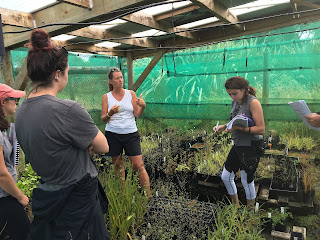Today,
we went to the Antarctic Centre in Christchurch. It has a museum covering the
history of Antarctica including the geology and various expeditions, some of
which are on going. In addition to that, there is also a center for Little Blue
Penguins and White-Flipper Penguins. They had 15 total, and each penguin was
there because they could not survive in the wild. Most of them had suffered a
traumatic injury that left them disabled. Amusingly enough, they even had a
penguin that was afraid of water. Our tour guide Diane allowed us to see the
penguins up close and told us about about how they came to the exhibit. After a
tour of their tank and how they are cared for, Diane fed them their breakfast
which was fun to watch.
Emily Stanek (Nursing ‘19) looks on at “Squirt”, the Little Blue Penguin, during our backstage visit at the Antarctic Centre in Christchurch.
The
Antarctic Center had a room which simulated an arctic storm. The room dropped
to 17°F and had 25 kph
winds. Everyone was definitely shivering after a minute or two and stepped back
out into the relatively warm museum. Once we were done with the exhibit we
headed outside where an animal rescue group had some huskies for people to meet
which was a pleasant surprise.
Our crew after we experienced an ‘Antarctic storm’!
After
our experiences at the Antarctic Centre, we drove back into Christchurch for
lunch. We had the rest of the day to ourselves and explored the city of
Christchurch. Overall today was a very good day.























